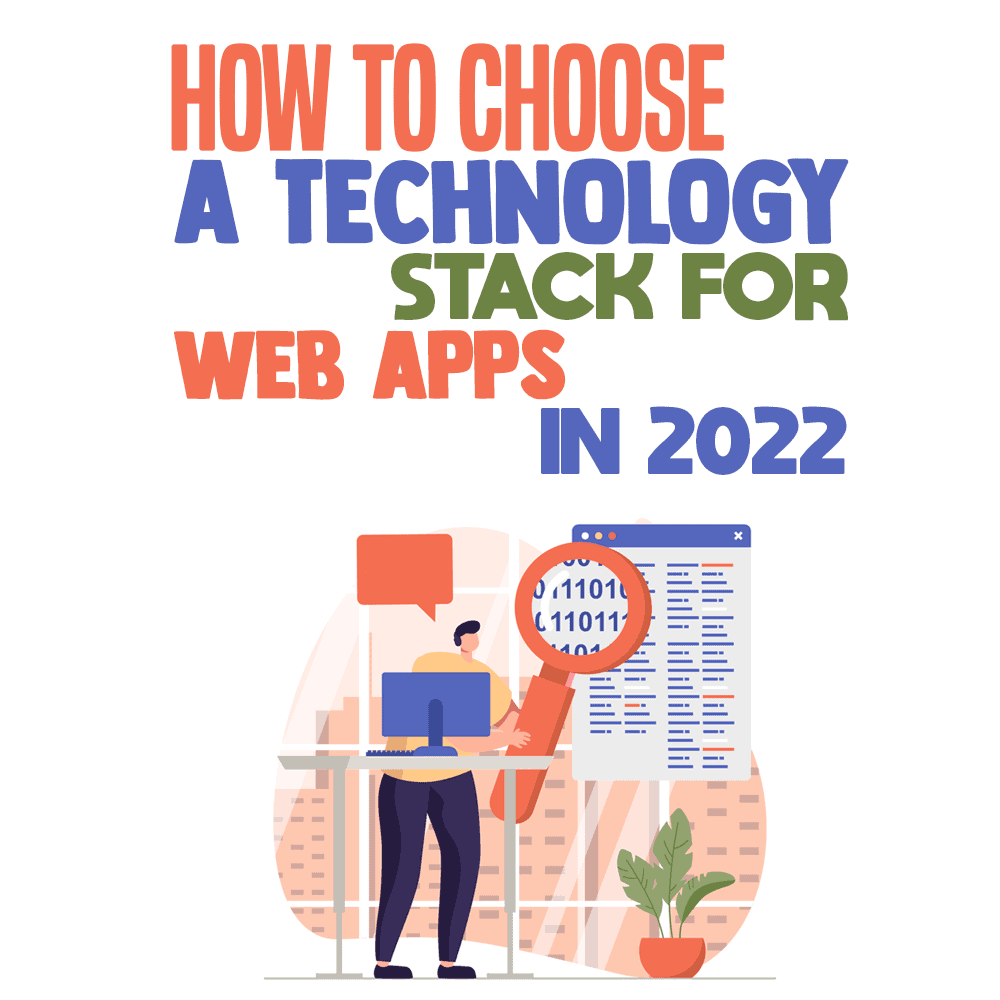
That is why choosing a tech stack may take more time than you expect.
In this article, I will help you choose the most effective tech stack for web development.
I will explain what technologies are available for selection, their advantages and disadvantages, and inform you on what technologies are suitable for different projects. I will also provide valuable recommendations on how to choose the right technology stack.
What Is a Technology Stack?
The term “technological stack” refers to a complex combination of programming languages, software, and a range of frameworks used to develop an app. It should be chosen on the planning stage of the web development process.
The architecture of any web application consists of two sides: client side (frontend) and server side (backend). The client side is the visualized data that users can see on their displays. It includes the following components:
- programming language, responsible for the interactive part of the web application,
- a documentation markup language that displays the website’s content in a browser,
- style sheet language used for describing the document’s presentation,
- UI frameworks.
The server side is not visible to the user. It provides data for the client side. The development of the server side involves the use of the following technologies:
- databases,
- backend programming language,
- frameworks,
- web server (serverless architecture also can be an option),
- cloud infrastructures and services.
So, how can you choose wisely from all the available options?
Things to Consider When Choosing a Technology Stack for Web Development
As I explained in the introduction, choosing a tech stack is crucial for the project you’re working on. The time and cost required, as well as the overall quality of the final product, are directly affected by your choice. To choose wisely, consider the following recommendations.
Choose Familiar Technologies
Let's say you want to create a simple web app with only a couple of functions. If you used a new but completely unfamiliar technology, you would inevitably waste way too much time fixing bugs and solving small issues—which you wouldn’t have faced if you had used simpler and more familiar technology.
In short, in such a scenario, a simple and understandable task turns into a nightmare and you no longer feel confident about your project.
So, if your software engineers are great at PHP development, there is no sense in using Node.js. Although you shouldn’t use outdated technologies—since they may lead to poor performance and technical support issues—you should still choose technologies that your development team knows inside and out, especially if you want to launch your web app as quickly as possible.
Follow the Trends

Technology trends are constantly changing. Top languages replace each other every 5-7 years, and frameworks every 2-3 years. It’s a good tactic to choose a modern web development stack, as it will help you avoid many problems in the future. According to Statista, the most commonly used programming languages in 2021 were JavaScript (64%), HTML/CSS (56%), and Python (48%).
It’s good to make sure that a technology of your choice is supported by a large community of developers that have an amazing career in software development. This way, in case of difficulties, you will quickly find specialists to help you fix them.
Overall, you should trust your developers. Ask them about the pros and cons of technologies that are potentially suitable for the development of your web application. The technical expertise of specialists will help minimize the risks in the future.
Consider the Specifics of Your Project
Choose a tech stack considering the size and the purpose of your web application. For example, for small, single-page websites, the Node.js and React.js stack will do the job. Web apps of medium size (like shopping websites, for example) require more complex tech stacks, several levels of programming languages, and several frameworks.
As for large projects, you will need a stack capable of working with significant amounts of data and maintaining the required level of web app’s performance.
Moreover, keep in mind the evolution of your app. Your web app will definitely require technical support and updates in the future. So, when choosing a tech stack, think about your plans for the app’s future development: Maybe you want to make it available on other devices? Or want to add some additional functions?
Ensure High Security Level
The security of the users’ personal data is of primary importance. If your service includes an online payment system, you should prefer technologies that provide maximum security and inaccessibility to cyber attacks when forming a stack.
Remember Your Deadlines
If your project has strict deadlines, it will be a wise decision to resort to ready-made solutions of the technology stack. This will decrease the overall web application development time.
LAMP, MERN, and MEAN are among the most sought-after models. They will work for various medium-to-large-scale web applications. Nevertheless, it doesn’t mean that they will definitely be suitable for any project—your personal project may require a more creative approach.
Choosing Front-End Tech Stack
Let’s now take a look at how you can optimally choose a tech stack for the front end, in terms of frameworks as well as programming languages.
Framework
The most common frontend frameworks for web development are React.js, Angular.js, and Vue.js.
React.js is a free and open-source front-end JavaScript library for building user interfaces. It was created by Facebook and has gathered a large community around itself in less than a decade. It’s used for developing simple web applications. It comes in handy when developing complex front-end logic.
This UI library allows for fast and low-cost development. That is why it’s more popular than, for example, Angular. Moreover, since this is a very common technology, it won’t be a difficult task to find a qualified React programmer.
This is a very popular UI library that is unlikely to go out of use in the next 10 years, due to the fact that it is supported by Facebook and is used by millions of developers.
AngularJS is the biggest competitor to React. This framework is perfect for complex, advanced web apps. If you want to build a web app on Angular, you will need to thoroughly plan the development before it even starts.
Development on Angular means higher-quality results, but it also requires more time and money. Plus, it’s very difficult to learn this framework—which makes it harder to find a developer who works with Angular.
It will be a win-win idea to choose Angular if you need a complex web app with a simple interface and high-quality code.
As for Vue.js, it is an open-source JavaScript framework, which can be easily integrated into projects using other JavaScript libraries. Compared to React and Angular, this is a relatively new technology. That is why it doesn’t have too much support and there are no guarantees that it will stay relevant for many years.
Despite all this, as practice shows, Vue.js is a very good low-budget, simple technology—meaning, you won't need a skilled engineer. This is a great choice if you need to develop a small web application or MVP as quickly as possible and have a limited budget and small team.
Programming Language
When developing the client side of a web application, you need to decide on the main development language. Here we have two obvious options, JavaScript and TypeScript.
JavaScript is commonly used for creating dynamic and interactive web pages. It will allow you to create a beautiful and intuitive user interface. JS also enables complex animations that contribute a lot to the creation of a great user experience.
JavaScript is extremely popular and will probably keep its position for many years. Over 97% of websites are built with JavaScript on the client side. All major web browsers have a dedicated JavaScript engine.
TypeScript was created by Microsoft. If you are planning to develop your app using Angular, it’s better to choose TypeScript. However, when working with React and Vue.js, TypeScript is a bad choice: They just don’t integrate well, which may be a problem for developers that don’t have enough experience.
TypeScript allows you to save time on development and make your app simpler and more convenient for your clients. It is also supported by all modern frameworks.
Choosing Backend Technology Stack
And now it’s time to see your options regarding the backend technology stack.
Programming Language
There are many programming languages that can help you build the logic of your app. Let’s look at the three most popular of them:
Ruby is an interpreted, high-level programming language that supports multiple programming paradigms. It allows for programming productivity and simplicity.
PHP is a general-purpose scripting language. Currently, it’s supported by the vast majority of hosting providers, being one of the leading languages used to build dynamic websites.
Finally, Python is a high-level programming language, focused on improving the developer’s productivity, code readability, and quality. It works for both small and large-scale projects.
So, Ruby will work for those who need a simple programming language; PHP is great for building dynamic websites; Python is the best choice for large-scale projects.
Database

PostgreSQL. It’s used for financial and scientific projects and can boast a powerful SQL engine, being able to effortlessly process large amounts of data.
MySQL. It can ensure high performance and scalability and is universal for most types of apps.
Redis. It’s a good choice when super-fast response time is needed. The high speed of this database is very useful for real-time apps.
The Technology Stack Is the Core of Your App
The technology stack has a very strong influence on the future of any web application. It affects the cost of development, development time, scalability and many other elements. Put simply, the technology stack is the core of your app.
Your choice of technologies should ultimately depend on your purpose, what you want to achieve.
Therefore, in order to choose the best tech stack for a web app, it’s necessary to familiarize yourself with the advantages and disadvantages of all available technologies, and then consult with experienced developers.
